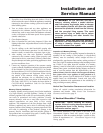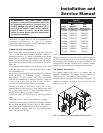
Installation and
Service Manual
23
Drain Tee Installation
A drain tee must be installed in the vent pipe to collect and
dispose of any condensate that may occur in the vent system.
The drain tee must be installed as the first fitting after the
horizontal ell on the top of the unit (see FIG. 23B). Plastic
drain tubing, sized per the vent manufacturer’s instructions,
shall be provided as a drain line from the tee. The drain tubing
must have a trap provided by a 3" (7.6cm) diameter circular
trap loop in the drain tubing. Prime the trap loop by pouring a
small quantity of water into the drain hose before assembly to
the vent. Secure the trap loop in position with nylon wire ties.
Use caution not to collapse or restrict the condensate drain line
with the nylon wire ties. The condensate drain must be routed
to a suitable drain for disposal of condensate that may occur in
the direct vent system. Refer to the condensate drain
installation instructions as supplied by the manufacturer of the
vent material.
FIG. 23B Aire-Lock Direct Vent (Illustration with Sidewall
Vent and Sidewall Combustion Air)
Connect the flue vent directly to the flue outlet opening on the
top of unit. Make the connections from the unit vent to the
outside stack as direct as possible with no reduction in
diameter. Provide adequate clearance to combustibles for the
vent connector and firestop. Follow the vent manufacturer’s
instructions when installing sealed AL29-4C vents and
accessories, such as firestop spacers, vent connectors,
thimbles, caps, etc.
Provide adequate clearance to combustibles for the vent
connector and firestop.
When planning the venting system, avoid possible contact with
plumbing or electrical wiring inside walls, ceilings, and floors.
Locate the unit as close as possible to chimney or gas vent.
When a vent system is disconnected for any reason, the flue
must be reassembled and resealed according to the vent
manufacturer’s instructions.
The installed length of flue from the unit to the outside point
of termination must not exceed 50 equivalent feet (15.2m).
Subtract 5 feet (1.5m) of equivalent length for each 90° elbow.
Subtract 2.5 feet (0.7m) of equivalent length for each 45°
elbow.
Vertical DV Venting Termination
You must use the vent termination recommended by the vent
manufacturer for vertical direct vent terminations. Follow all
vertical venting termination information for clearances and
location under Vertical Vent Termination Clearances and
Location, page 11.
Masonry Chimney Installation
Do not use a standard masonry chimney to directly vent the
combustion products from this unit.
To use a masonry chimney, the chimney must use a sealed,
corrosion-resistant liner system. Sealed, corrosion-resistant
liner systems (single-wall, double-wall, flexible, or rigid) must
be rated for use with a high efficiency, positive pressure vent
system.
Corrosion-resistant chimney liner systems are typically made
from a high grade stainless steel such as AL29-4C. The liner
must be properly sized and fully sealed throughout the entire
length. Both the top and bottom of the masonry chimney must
be capped and sealed to provide a dead air space around the
liner.
ƽ WARNING: Do not combine the flue from
this unit with the vent from any other appliance.
Do not combine flues from multiple appliances
into a common vent. The flue from this unit
must be a dedicated stack.
ƽ WARNING: Do not vent this unit into a
masonry chimney without a sealed stainless
steel liner system. Any breaks, leaks, or damage
to the masonry flue/tile will allow the positive-
pressure flue products to leak from the chimney
and into occupied living spaces. This could
cause serious injury or death due to carbon
monoxide poisoning and other harmful flue
products.
IMPORTANT: Check with local code officials to
determine code requirements or the advisability
of using a masonry chimney with a sealed
corrosion-resistant liner system.


















